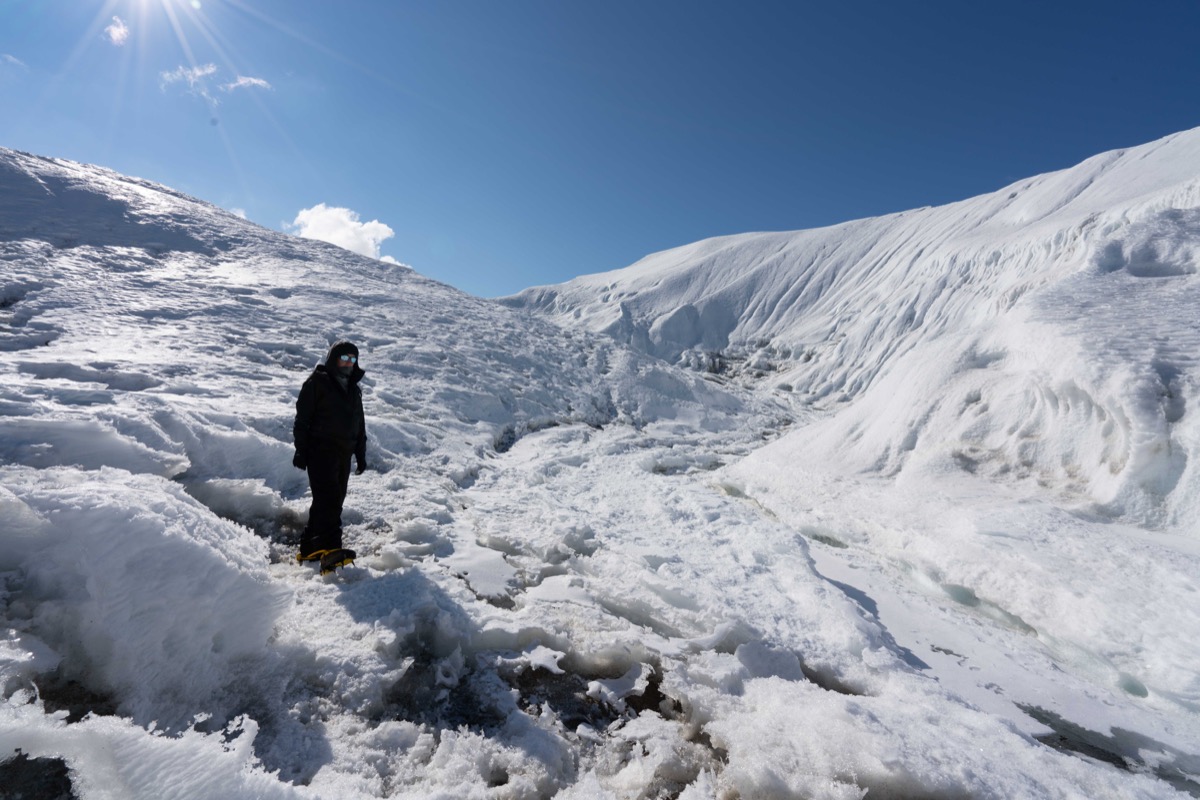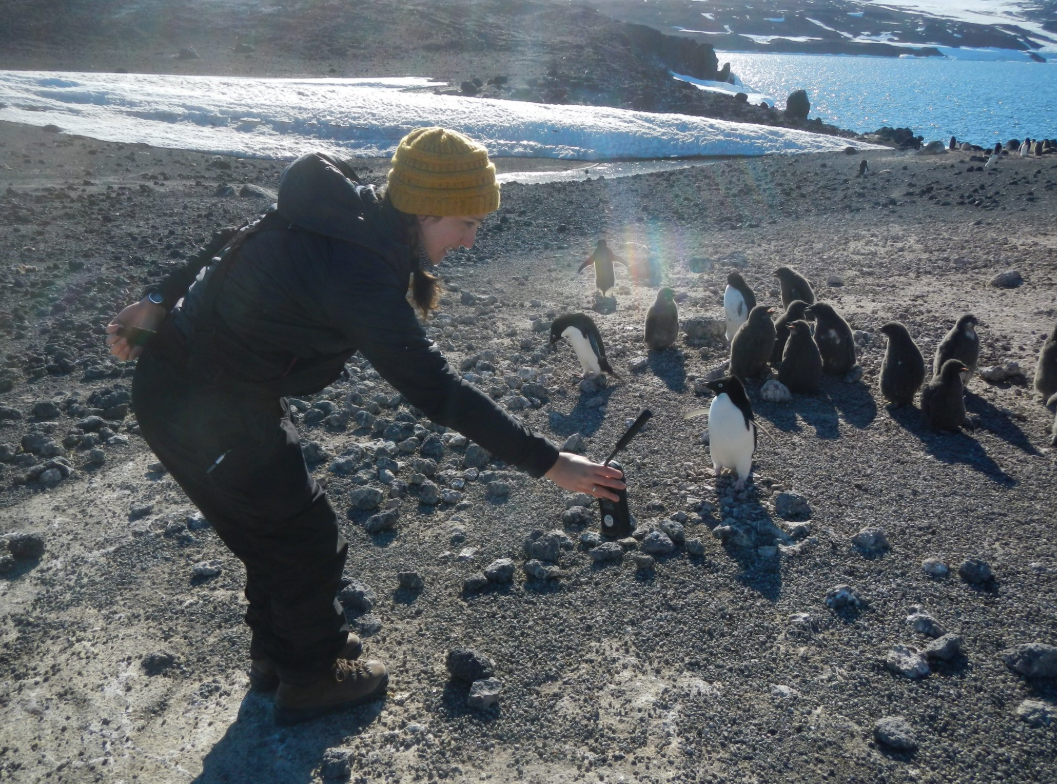A Phone Call From A Penguin Colony
4:13 minutes

Although North America is in the middle of winter, the continent of Antarctica is in the middle of its summer—and that’s prime time for scientific research projects based there. Science Friday’s education director, Ariel Zych, has been exploring the research happening in and around McMurdo Station, including trips to ecological monitoring projects in the Antarctic dry valleys, work in the station’s labs, and an expedition to band chicks in the Cape Royds Adélie penguin colony. She calls in via satellite phone to check in.

Ariel Zych was Science Friday’s director of audience. She is a former teacher and scientist who spends her free time making food, watching arthropods, and being outside.
JOHN DANKOSKY: We’ve got someone on the line here now. Science Friday’s own education director, Ariel Zych, has been in Antarctica. And today, she managed to get a hold of a satellite phone. And she’s calling this up from a penguin colony. Ariel, are you there? Can you hear us?
ARIEL ZYCH: I am. I can hear you loud and clear, John.
JOHN DANKOSKY: Thanks so much for calling into the show. I guess I should ask you, first of all, where are you exactly?
ARIEL ZYCH: Well, I’m in Antarctica, as you mentioned. I am a 45-minute helicopter flight outside of McMurdo Station. And I’m here at Cape Royds penguin colony, which is a colony of about 2,500 nesting Adélie penguins.
JOHN DANKOSKY: And what are you doing there? What are they doing with the penguins?
ARIEL ZYCH: This time of year is a special time of year for penguin researchers. It’s right before the chicks of the year fledge and start foraging on their own. And it’s our last chance to get a full count and wait on the chicks of the colony and do penguin banding. So they’ve each had little flipper tags. And those tags are what researchers here with Dr. David Ainley’s group are using to track their return rate, so the likelihood that they’ll return after a couple of years as juveniles and come back and mate. It’s fun.
JOHN DANKOSKY: I’m wondering if you could describe the scene for us. Because what I’m imagining is these lines of little penguins very orderly waiting to be banded. What does it look like? Describe how many penguins we’re talking about here.
ARIEL ZYCH: [LAUGHS] Well, it’s nothing like order, I can tell you that. It’s more like chaos. The penguins right now are really fluffy. So the chicks are very fluffy. They’re about as tall as their parents. They’re still very closely attached. And what they do is, because they stick very close to the nest in these colonies, where they’re save from skua attacks, which is a predatory seabird here. They stay pretty close to these nests.
So we kind of just approach them slowly with a fence until they fence them in and the close the fence around them. And then they pull all the adults out. And you can’t imagine the smell and the amount of fluff that goes on because these birds are actively molting. So there’s just penguin down floating everywhere and quite a bit of poop.
I mean, it’s amazing how efficient these researchers are. It’s clear that they do this a lot. They’ve got some really interesting new things they’re looking at. They’re interested in the virology of these penguins. So they’re taking some samples for that.
And they’ve got, you know, some really interesting stories to tell too about climate change because they’ve been doing this process for so long with a few colonies. Here in Antarctica, they’ve got a really clear picture of how these populations are changing with things like sea ice. You know, it’s quite the effort. But the great penguin corral is doing its job.
JOHN DANKOSKY: What’s the weather like there today?
ARIEL ZYCH: It’s beautiful. There’s a light breeze. It’s maybe 7 degrees Fahrenheit out. I’m not even wearing Big Red today. Big Red is the large, red down coat that’s kind of like a sleeping bag you wear. We don’t even need it on a day like today. You know, sunglasses and sunscreen are really indicated because the sun is so bright here.
But you know, we have a hot breakfast at the station. We put on our boots and our extreme weather gear for the helicopter flight. And then by the time we get to this colony, we’re cooking. And so we strip down and get in our proper field equipment, which is just hiking boots, warm pants, a fleece. It’s not much more than that. It’s really pretty accessible.
JOHN DANKOSKY: Well, before I let you go, Ariel, I have to say this. There’s an iconic picture of Ira Flatow holding up a microphone to a penguin in Antarctica. I’m wondering, are you going to do that? Are you going to record some penguins for us?
ARIEL ZYCH: [LAUGHS] I am going to record some penguins. It’s going to look a little bit more like a camera. And in this case, it’ll look like me holding a sat phone up for the Penguins. We’ll see if you guys can hear that on the way out. But yeah, I’ll do my best. I’ll do my best.
JOHN DANKOSKY: OK. Well, I’ll let you go now. If you’re near enough penguins, maybe you can hold the microphone up to one and see if we can hear one.
ARIEL ZYCH: You got it. I’ll do my best, John. Thanks a lot.
JOHN DANKOSKY: OK. Thanks so much. Ariel Zych is the education director for Science Friday. She’s been joining us from the bottom of the world in Antarctica.
[PENGUIN CHATTER]
Well, maybe we can hear some penguins there in the background. That’s very cool. Thanks for joining us, Ariel.
ARIEL ZYCH: [INAUDIBLE] Have a good one.
Copyright © 2019 Science Friday Initiative. All rights reserved. Science Friday transcripts are produced on a tight deadline by 3Play Media. Fidelity to the original aired/published audio or video file might vary, and text might be updated or amended in the future. For the authoritative record of Science Friday’s programming, please visit the original aired/published recording. For terms of use and more information, visit our policies pages at http://www.sciencefriday.com/about/policies/
As Science Friday’s director and senior producer, Charles Bergquist channels the chaos of a live production studio into something sounding like a radio program. Favorite topics include planetary sciences, chemistry, materials, and shiny things with blinking lights.
John Dankosky works with the radio team to create our weekly show, and is helping to build our State of Science Reporting Network. He’s also been a long-time guest host on Science Friday. He and his wife have three cats, thousands of bees, and a yoga studio in the sleepy Northwest hills of Connecticut.